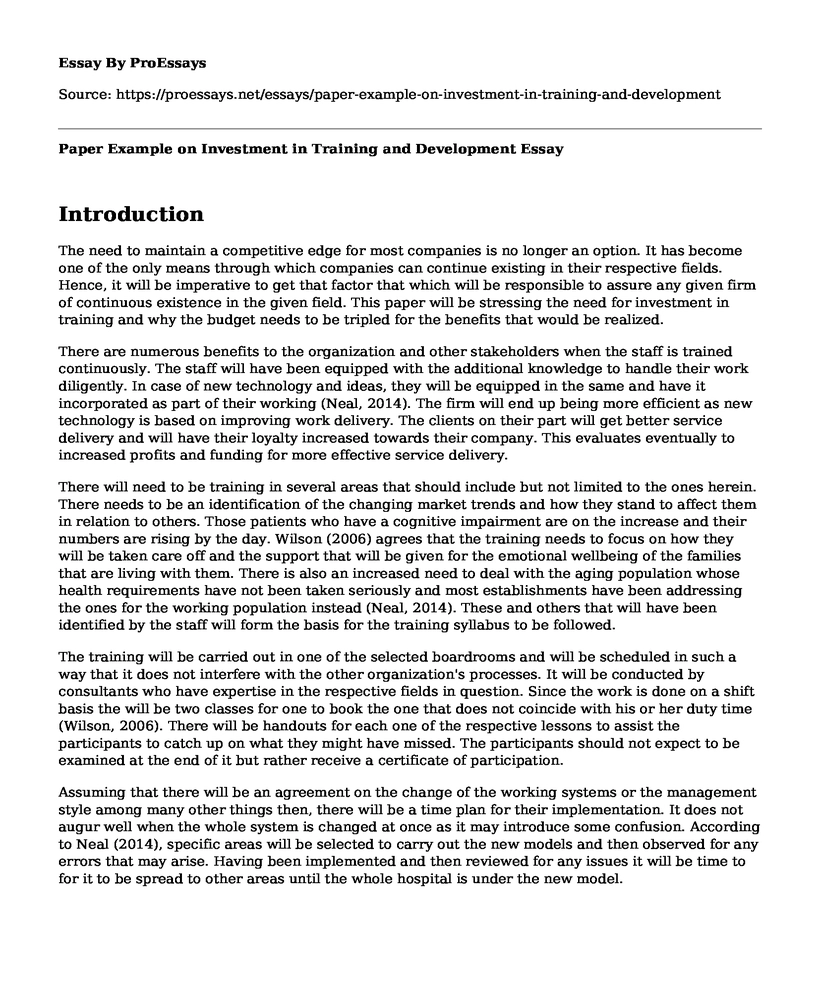Introduction
The need to maintain a competitive edge for most companies is no longer an option. It has become one of the only means through which companies can continue existing in their respective fields. Hence, it will be imperative to get that factor that which will be responsible to assure any given firm of continuous existence in the given field. This paper will be stressing the need for investment in training and why the budget needs to be tripled for the benefits that would be realized.
There are numerous benefits to the organization and other stakeholders when the staff is trained continuously. The staff will have been equipped with the additional knowledge to handle their work diligently. In case of new technology and ideas, they will be equipped in the same and have it incorporated as part of their working (Neal, 2014). The firm will end up being more efficient as new technology is based on improving work delivery. The clients on their part will get better service delivery and will have their loyalty increased towards their company. This evaluates eventually to increased profits and funding for more effective service delivery.
There will need to be training in several areas that should include but not limited to the ones herein. There needs to be an identification of the changing market trends and how they stand to affect them in relation to others. Those patients who have a cognitive impairment are on the increase and their numbers are rising by the day. Wilson (2006) agrees that the training needs to focus on how they will be taken care off and the support that will be given for the emotional wellbeing of the families that are living with them. There is also an increased need to deal with the aging population whose health requirements have not been taken seriously and most establishments have been addressing the ones for the working population instead (Neal, 2014). These and others that will have been identified by the staff will form the basis for the training syllabus to be followed.
The training will be carried out in one of the selected boardrooms and will be scheduled in such a way that it does not interfere with the other organization's processes. It will be conducted by consultants who have expertise in the respective fields in question. Since the work is done on a shift basis the will be two classes for one to book the one that does not coincide with his or her duty time (Wilson, 2006). There will be handouts for each one of the respective lessons to assist the participants to catch up on what they might have missed. The participants should not expect to be examined at the end of it but rather receive a certificate of participation.
Assuming that there will be an agreement on the change of the working systems or the management style among many other things then, there will be a time plan for their implementation. It does not augur well when the whole system is changed at once as it may introduce some confusion. According to Neal (2014), specific areas will be selected to carry out the new models and then observed for any errors that may arise. Having been implemented and then reviewed for any issues it will be time to for it to be spread to other areas until the whole hospital is under the new model.
Conclusion
It will now be time to look back and realize if there are any benefits that the form is realizing. This will also be time to produce reports outlining the cost-benefit analysis for record purposes. At the end of the day at some time in the future depending on the changes on the ground there will be a need for other major changes in a similar fashion. The management will appreciate the need for investment in training on development depending on the results on the ground. It is important for various firms to have a positive approach to this department as it is among the only ways that they can maintain their competitiveness.
References
Neal, B. (2014). How to develop training quality standards. Alexandria, Virginia: ASTD Press.
Wilson, J. P. (2006). Human resource development: Learning & training for individuals & organizations. London: Kogan Page.
Cite this page
Paper Example on Investment in Training and Development. (2022, Jul 01). Retrieved from https://proessays.net/essays/paper-example-on-investment-in-training-and-development
If you are the original author of this essay and no longer wish to have it published on the ProEssays website, please click below to request its removal:
- The Graduate Capabilities Sought by Employers Paper Example
- Research Paper on Sally McMillan: Achieving a Milestone in CCI Faculty Career
- Essay Sample on Tactical Decision: The Main Cause of IT Outsourcing Projects
- Essay on Applying for International Baccalaureate (IB) Diploma Program (DP): Exploring My Future Career Path
- Essay Example on Forced Ranking: Unmotivating Employees?
- Essay on Performance Criteria: Establishing Individual Capabilities for Company Success
- Feedback: Reasons, Forms, and Benefits for Performance Improvement - Paper Sample







